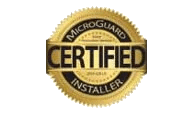
Staining vs Etching on Natural Stone
Sometimes, things may look the same, but in reality, they are 2 completely different things. This can sometimes be the case with staining and etching on natural stone. These 2 things are the most common issues that can damage your natural stone projects.
What is staining?
Natural stone (with the possible exception of soapstone) is considered a porous material. This means that it can absorb moisture and liquid. Any absorbed moisture can cause discoloration in the stone. This discoloration is a stain. Stains normally do not affect the surface of the stone and if you rub your fingers over the affected area, there should be no change to the feel of the surface.
What can cause a stain on stone?
There are a lot of different things that can stain your natural stone. Tea, wine, cooking oil, fruit juice, and cleaning agents are just a few of the things that can cause stains on natural stone surfaces.
What can be done to prevent stains?
- Make sure your stone is sealed with a quality impregnating sealer. A sealer will not prevent staining by itself. What it will do is slow down absorption to give you more time to deal with the spill.
- Always make sure to use a cutting board on kitchen countertops.
- Wipe up any liquid or debris as soon as possible.
What if my stone does stain?
If you do happen to get a stain, there are things you can do.
- Click on the resources tab on our website and then click on the Stain Management App. Enter the kind of stain it is in the stain database and follow the instructions on how to remove the stain.
- If you aren’t comfortable with a DIY approach, please feel free to call us for assistance. Or send us a message on our contact page.
What is etching?
Many times, etching is confused with staining, when in fact they are two different issues. Etching happens when an acidic substance comes in contact with the stone and “eats” away at the surface of the stone. The etch mark will look dull and possibly whitish. Etches change the smooth surface of the stone. If you run your fingers over the affected area, it can feel rough. Etches are also often mistaken for water spots.
What can cause etching on natural stone?
There are many different things that can etch your natural stone. Vinegar, coffee, and soda are just a few of the things that can leave etch marks on your stone.
What can be done to prevent etching?
- Always make sure you use a cutting board on kitchen countertops.
- Don’t spread the spill. Blot it up with a sponge or paper towel. Then rinse and dry the area.
- Don’t use acidic cleaners on your stone projects.
What if my stone does etch?
If you do happen to get etches in your stone, it is best to contact a professional for help. There are removers on the market and a professional fabricator or restoration contractor will know how best to deal with the product and the stone you have.
While staining and etching are two different things, they are not mutually exclusive. It is entirely possible for a stain to appear in an etched area of stone and vice versa. That being said, one of the best reasons to use natural stone for your projects is that it is a renewable and restorable material. If it is damaged, you don’t have to replace it. It can be fixed and restored.
(A tip for someone who has not purchased their stone yet: Think about getting a honed finish instead of a polished finish. A honed finish is a matte finish and not shiny. One of the reasons etch marks are so noticeable is because they create a dull area on a polished finish. If your surface is not shiny, the etch will show much less.)
By Sharon Koehler. This article is one of a series of articles written and published on behalf of Surface Care PRO Partners.











